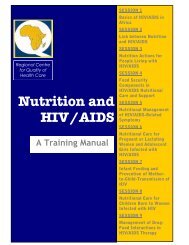Final Report - Linkages Project
Final Report - Linkages Project
Final Report - Linkages Project
Create successful ePaper yourself
Turn your PDF publications into a flip-book with our unique Google optimized e-Paper software.
2.) Methodology<br />
End-line Sampling. In the end-line surveys of ODs and PD, communes were selected using the population<br />
proportional cluster sampling method, and thereafter fonkontany were also selected the same way. The purpose of<br />
the end-line sampling was to determine the level of ENA indicators across the entire designated district, not just in<br />
specific sites in the district where LINKAGES had been active.<br />
RAP Sampling. The RAP sampling strategy, explained in more detail in Annex 2, was intended to track the levels of<br />
ENA indicators over time from purposively selected communes in the initial focus districts. These communes were<br />
selected by LINKAGES’ field staff during the first year of the project using the criteria that they were actively engaged<br />
with the ENA and BCC strategies. Thus, the data from the RAP provides a reflection of the best results that can be<br />
achieved under the most optimal real life circumstances when active community involvement existed. However, over<br />
time the level of engagement of these communes was not assessed, so there is no way to determine if this fluctuated<br />
or diminished over the years. As with the end-line survey, the selection of fonkontany within these selected<br />
communes was also carried out using a population-proportional cluster sampling method.<br />
Table 1 provides details of the baseline and end-line surveys as well as the RAP 2005 survey.<br />
Table 1: Description of surveys and samples, over time<br />
Survey Type<br />
Survey<br />
Sample Size<br />
Date 0-5 months 6-11 months 12-23 months<br />
Sampling Methodology<br />
Survey<br />
Population<br />
OD Baseline<br />
(by BASICS I<br />
project)<br />
Oct 1996 370 351 720 Stratified cluster sampling across communes,<br />
by district over BASICS’ two focus districts<br />
PD Baseline Feb 2000 320 280 600 Stratified cluster sampling across communes,<br />
by district over 7 focus districts<br />
OD End-line Nov 2005 320 320 320<br />
Stratified cluster sampling across communes,<br />
by district over old BASICS’ two focus<br />
districts<br />
PD End-line Nov 2005 500<br />
7 th district, Betafo, was dropped in 2004)<br />
515 745 Stratified cluster sampling across communes,<br />
by district over 6 focus districts (the original<br />
RAP Oct 2005 320 320 320<br />
Purposeful stratified cluster sampling in 8<br />
focus districts (most active communes only<br />
selected in RAP2000)<br />
Mothers of<br />
children less<br />
than 23<br />
months old<br />
Control Sample. A control site was included in the end line survey and all RAPs. The control was selected to match<br />
project districts and was randomly selected from the same region and eco-system. However, after the survey was<br />
conducted, a decision was made not to use these data, as contamination seemed to have taken place due to<br />
unanticipated factors (e.g. presence of health staff originally trained by project and transferred to control site, active<br />
engagement of other partner groups trained by project, broadcast of project messages into control sites. etc). This<br />
type of problem with maintaining “pure” control sites is not uncommon when broad scale behavior change<br />
communication programs are assessed since health staff trained in project activities may move to new areas of the<br />
14

















